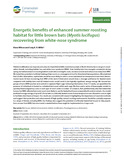| dc.contributor.author | Wilcox, Alana | |
| dc.contributor.author | Willis, Craig K. R. | |
| dc.date.accessioned | 2016-12-08T23:09:49Z | |
| dc.date.available | 2016-12-08T23:09:49Z | |
| dc.date.issued | 2016 | |
| dc.identifier.citation | Wilcox, A., and C. K. R. Willis. "Energetic benefits of enhanced summer roosting habitat for little brown bats (Myotis lucifugus) recovering from white-nose syndrome." Conservation Physiology 4(1) (2016): cov070. DOI: 10.1093/conphys/cov070. | en_US |
| dc.identifier.issn | 2051-1434 | |
| dc.identifier.uri | http://hdl.handle.net/10680/1256 | |
| dc.description.abstract | Habitat modification can improve outcomes for imperilled wildlife. Insectivorous bats in North America face a range of conservation threats, including habitat loss and white-nose syndrome (WNS). Even healthy bats face energetic constraints during spring, but enhancement of roosting habitat could reduce energetic costs, increase survival and enhance recovery from WNS. We tested the potential of artificial heating of bat roosts as a management tool for threatened bat populations. We predicted that: (i) after hibernation, captive bats would be more likely to select a roost maintained at a temperature near their thermoneutral zone; (ii) bats recovering from WNS at the end of hibernation would show a stronger preference for heated roosts compared with healthy bats; and (iii) heated roosts would result in biologically significant energy savings. We housed two groups of bats (WNS-positive and control) in separate flight cages following hibernation. Over 7.5 weeks, we quantified the presence of individuals in heated vs. unheated bat houses within each cage. We then used a series of bioenergetic models to quantify thermoregulatory costs in each type of roost under a number of scenarios. Bats preferentially selected heated bat houses, but WNS-affected bats were much more likely to use the heated bat house compared with control animals. Our model predicted energy savings of up to 81.2% for bats in artificially heated roosts if roost temperature was allowed to cool at night to facilitate short bouts of torpor. Our results are consistent with research highlighting the importance of roost microclimate and suggest that protection and enhancement of high-quality, natural roosting environments should be a priority response to a range of threats, including WNS. Our findings also suggest the potential of artificially heated bat houses to help populations recover from WNS, but more work is needed before these might be implemented on a large scale. | en_US |
| dc.description.sponsorship | This work was supported by scholarships from the Natural Sciences and Engineering Research Council (NSERC, Canada) and University of Winnipeg Graduate Studies to A.W. and grants from the US Fish and Wildlife Service, Bat Conservation International and NSERC to C.K.R.W. | en_US |
| dc.description.uri | https://academic.oup.com/conphys/article/4/1/cov070/2951313 | |
| dc.language.iso | en | en_US |
| dc.rights | info:eu-repo/semantics/openAccess | |
| dc.subject | Little Brown Bat | en_US |
| dc.subject | White-nose syndrome | en_US |
| dc.title | Energetic benefits of enhanced summer roosting habitat for little brown bats (Myotis lucifugus) recovering from white-nose syndrome | en_US |
| dc.type | Article | en_US |
| dc.identifier.doi | 10.1093/conphys/cov070 | |

